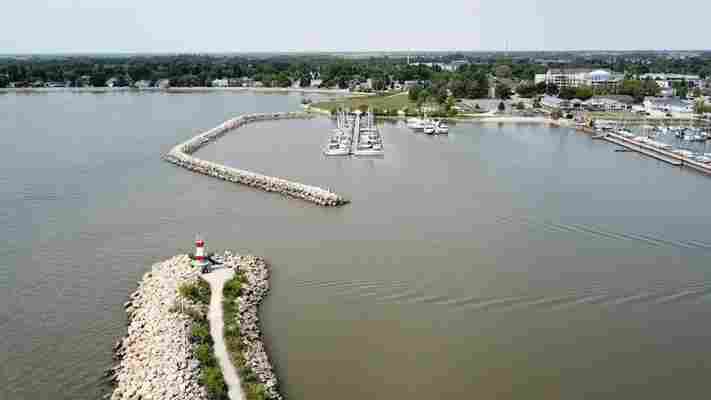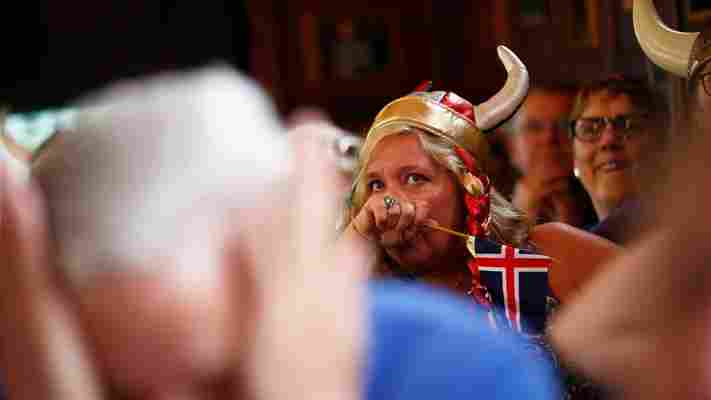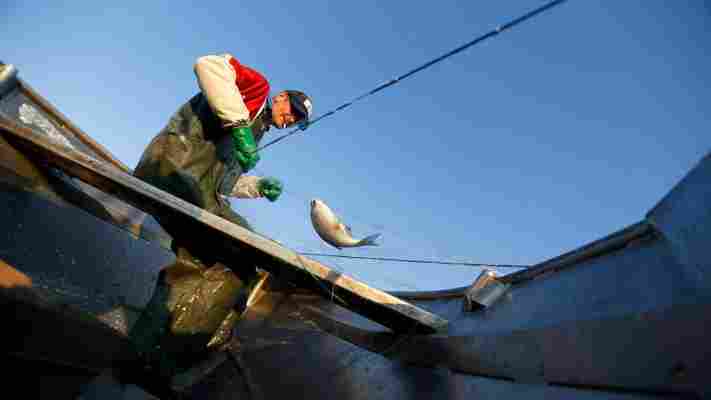Article continues below

A quote from the Völuspá, a Nordic epic myth (Credit: John Woods)
She sees a hall standing, fairer than the sun, Thatched with gold, at Gimlé; There shall trustworthy people dwell And throughout all ages enjoy bliss. – from the Völuspá, a Nordic epic myth

In Gimli, football fans watch Iceland take on Argentina in the World Cup (Credit: John Woods)
It’s bright and early on a Saturday morning and the Ship and Plough Tavern in Gimli, Manitoba, is already packed with football fans watching Iceland take on Argentina in the World Cup. Wearing Viking horns and blue jerseys, there’s no doubt who the home team is.
Gimli, a tiny town of just more than 2,000, is the heart of ‘New Iceland’ in Canada, a region that boasts the most Icelanders outside of Iceland. Located about an hour north of Winnipeg, the town was founded by Icelandic immigrants in the late 19th Century.
It’s a legacy the descendants of these first pioneers are still proud of.
“Living in this community, it’s around us all the time,” said Lorna Tergesen, who along with her son Stefan runs Tergesen’s General Store in Gimli centre. The store was founded in 1899 by Stefan’s great-grandfather, an Icelandic merchant.

Gimli was rich with timber and the lake promised ample fish (Credit: John Woods)
In the Norse mythological text the Völuspá, Gimlé is a pagan heaven, a golden-roofed hall where the survivors of Ragnarök – or Armageddon – spend their afterlife. And heaven is what the land now known as Gimli must have seemed like to the first Icelandic settlers when they arrived at Willow Point, a peninsula jutting out from what is now Gimli harbour, on 21 October 1875.
Located along the south-eastern shores of Lake Winnipeg, the area around Gimli was rich with timber and the lake promised ample fish. The land had been given to the settlers by the Government of Canada, and since it was not yet part of the province of Manitoba, they were allowed to govern themselves.
This unique political experiment offered Icelanders – who for centuries had lived under Danish rule – an opportunity to build the society they wanted. Just nine days after arriving, before they had even built shelter, the townspeople wrote of their intention to open a school, and within two years they had established their own newspaper and constitution.
“The Icelanders in the colony are desirous of having a school" (Credit: New Iceland Heritage Museum)
The Icelanders in the colony are desirous of having a school for their children as soon as they can put up a school house. – Icelandic Agent John Taylor to the Lieutenant Governor of Manitoba, 30 October 1875
Ambient Map 1920x1080
How did these people from an island in the middle of the North Atlantic come to settle in the heart of the Canadian prairie?
Frequent volcanic activity had covered large parts of Iceland in ash, making the land difficult to farm. Famine and plagues were common, as was political unrest. The situation was dire enough that between 1870 and the early 1900s, about 15,000 Icelanders – or about 20% of the total population – would emigrate to North America.
In 1874, about 350 Icelanders arrived in Kinmount, Ontario, with hopes of working on the railroad. There were not enough jobs to go around, so after two years, many voted to travel to the north of Manitoba, where they heard the fishing was good and land was free.
They took a train to Sarnia, Ontario, and then a steamship across the Great Lakes to Duluth, Minnesota. From there, they travelled to Grand Forks, North Dakota, and up the Red River to the city of Winnipeg, where some decided to permanently settle. From there, the remaining 200 or so continued along the Red River to the south-eastern shores of Lake Winnipeg, where they began to build their new colony.
In 1876, a smallpox epidemic ripped through the community of New Iceland (Credit: John Woods)
The land given to them was not empty. About 60 indigenous people lived in a nearby community called Sandy Bar, a fact the Canadian government had not thought to investigate. Among them was John Ramsay, who helped the first settlers learn to fish through the lake’s frozen waters and hunt local animals.
By summer 1876, the remote pioneer outpost had ballooned from just a couple of hundred settlers to nearly 2,000, as more and more Icelanders decided to emigrate for a better life.
But tragedy would cut this New Iceland experiment short. In 1876, a smallpox epidemic ripped through the community, claiming the lives of hundreds of Icelandic and indigenous people – including members of Ramsay’s family. The provincial government put them under quarantine, which cut the Icelanders off from trade with the rest of Canada and strangled their fledgling economy.
By 1881, the population had shrunk back to just more than 100, as a great exodus of Icelanders moved south to Winnipeg and the US for more job opportunities.
Margrét Hallgrímsdóttir: “There’s a lot of ‘love’ between the people here and Iceland" (Credit: John Woods)
There’s a lot of… I would use the word ‘love’, between the people here and Iceland,” said Margrét Hallgrímsdóttir, director of the National Museum of Iceland in Reykjavík.
Margrét Hallgrímsdóttir: “There’s a lot of ‘love’ between the people here and Iceland" (Credit: John Woods)
Although the political experiment of New Iceland ultimately failed (New Iceland became part of the province of Manitoba in 1881), Icelandic culture continued to thrive in the town, thanks to the descendants of those early settlers who carried many of the traditions along.
Since 1932, Gimli has hosted an annual Icelandic Festival – or Islendingadagurinn – on the first weekend of August. It’s a celebration of Icelandic culture, with traditional foods, music and games, culminating with the crowning of the Fjallkona, or maid of the mountain.
Day-to-day life in Gimli is a reminder of the community’s Icelandic roots (Credit: John Woods)
But day-to-day life in Gimli is also a reminder of the community’s Icelandic roots. In the morning, the descendants of Icelandic fisherman still sail their boats from Gimli Harbour to fish the stocks of Lake Winnipeg.
You can’t go to a community event without being offered at least one slice of somebody's amma’s (Icelandic for grandmother) vinarterta . The prune torte is a traditional Icelandic Christmas cake, but in Gimli it can be eaten all year.
However, perhaps no tradition is stronger than the pull of the mother tongue. Margrét Hallgrímsdóttir, director of the National Museum of Iceland in Reykjavík, says that the early settlers’ values of education and reading helped keep the Icelandic language alive in Canada despite the strong influence of French- and English-speaking neighbours.
“What was the most important thing for them to hold onto?” she asked. “You see that it’s the language.”
Icelandic is everywhere in Gimli today (Credit: John Woods)
Icelandic is everywhere in the community today – on the names of boats in the harbour, on street signs and in the storefronts in the centre of town.
Anna Stevens remembers that when she was a girl, she used to take notes in Icelandic for her father’s business so that he could read them. As an adult, she taught her children the old Icelandic songs. Now, at 95 years old, she still sings them at every family reunion, she said.
For her, the language is the thread that connects her to her heritage, and it’s something she is determined to keep going.
“It is very important to me,” she said.
As Gimli’s population ages, the younger generation leaves for cities like Winnipeg and Vancouver (Credit: John Woods)
But as Gimli’s population ages and the younger generation leaves for cities like Winnipeg and Vancouver, the number of native Icelandic speakers is beginning to dwindle.
That leaves Stevens and others like her as the keepers of the language in Canada. Every week, Stevens meets with other Icelandic speakers to practice the language and keep it alive.
“If you don’t use it, you lose it,” said 78-year-old Baldine Bjornsson.
“I remember when they first started coming, they really couldn't speak much Icelandic but it’s surprising how good they’re getting.”
Anna Stevens: "My grandchildren and children have all gone to Iceland" (Credit: John Woods)
My grandchildren and children have all gone to Iceland... they still have very close contact with their heritage and we want to keep it that way – it’s close their heart,” said Anna Stevens, the 95-year-old daughter of Icelandic immigrants.
More than 80,000 Canadians visited Iceland in 2016 (Credit: John Woods)
While the language may fade, the growing ease of travel have allowed many Icelandic-Canadians to reconnect with their homeland.
More than 80,000 Canadians visited Iceland in 2016, nearly double the number from the year before. The growth of online genealogy searches and social media have also made it easier for Icelandic-Canadians to reconnect with relatives.
“We love to drag up our lineage from way back,” said Lorna Tergesen, who on her next trip to Iceland this summer plans on having supper with several distant cousins.
“I have of course contacted every relative known there… so I am going to be very tired!”
(Video credit: John Woods)
